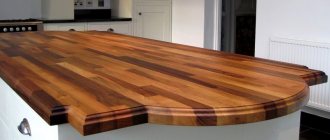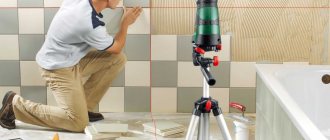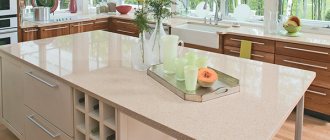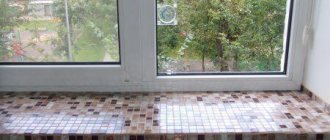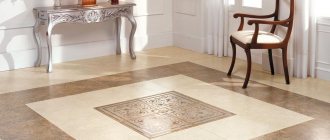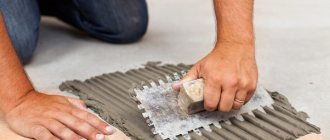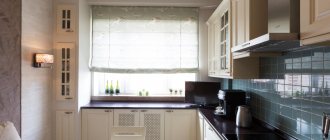There are quite a few options for making countertops for the kitchen, mainly plastic or acrylic products. But what can you say if the countertop for the kitchen unit is made of tiles? It is quite possible to do this yourself; to do this, you just need to follow all the recommendations indicated in this article.
Obviously, this countertop option wins in many respects: appearance, practicality and durability.
Advantages of tile products
Ceramics or porcelain stoneware cannot be called a new solution for finishing the kitchen area. But this is an unusual way to decorate a work surface. It is easy to highlight the advantages of tiles:
- practicality of ceramics - it is easy to wash and clean. No special detergents are required to clean the countertop. It is recommended to use compounds without abrasive additives;
- withstands temperature changes. You can safely put on a hot kettle or put out frozen food;
- moisture resistance is a guarantee that over time the work area does not deform from moisture;
A tile countertop is a great idea.
To cosmetically update the table, just refresh the grout at the seams. Such minor repairs will not even require dismantling the surface. And if you choose silicone of a different color, the entire kitchen will take on an updated look.
Types of tiles
This is an original competitor to other types of finishes when decorating a kitchen area. To cover the tabletop, ceramic squares with sides of 5, 10 or 15 cm are most often chosen. A table decorated with mosaics looks intricate and unusual.
You can successfully combine expensive designer items and textured details from other collections. The key to a stylish work area will be a natural combination of shades of elements.
This is an original competitor to other types of finishes
Ceramic variety
The material is clay. During the firing process, excess moisture is removed. Ceramics have many advantages. A variety of shades/textures, ease of installation, low cost, waterproof. Since the products tolerate high temperatures well, you can safely leave hot dishes on the table.
Disadvantage: It can crack or break off if a heavy object falls on the table. To make table maintenance easier, it is recommended to use sealed grout in a dark shade. Such compositions will not quickly get dirty and will protect the seams from grease and dirt.
Mosaic wealth
Such products are produced in squares with sides of 1, 2.5 cm. Typically, mosaics are sold in the form of large sheets attached to a mesh lining.
Advantages: easy installation, durability. The rich palette allows you to lay out original patterns and ornaments on the table. Thanks to the elegant multi-colored palette, chips on individual tiles are almost invisible.
The tiles withstand temperature changes
DIY countertop for bathroom sink
An original and inexpensive option for a bathroom countertop would be a concrete product. This design can be made with your own hands. Tools and materials you will need:
- cement M-400, river sand, gravel, glass cullet, plasticizer, dyes, varnish;
- wooden blocks, MDF sheet (laminated), slats;
- hammer, jigsaw, screwdriver (or screwdriver), self-tapping screws.
A rectangular sheet corresponding to the size of the future surface is cut out of an MDF sheet. Then, using a jigsaw, you make a hole for the sink in the countertop. It is better to equip a small bathroom with a medium-sized design.
When installing the countertop, you must follow a certain procedure.
Next, the MDF blank should be turned over and the legs should be attached to it. Then put it in its normal position and make a side of slats along the edge of the perimeter, including a cutout for the sink.
It is necessary to prepare a mixture of cement, sand, gravel and add a plasticizer. Dyes and broken glass can be distributed unevenly, this will only enhance the decorative effect of the tabletop. Pour the mixture into the prepared countertop mold.
Wait until the solution has completely hardened, then remove the sides, sand the outer and side surfaces and varnish.
A hand-made bathroom countertop will not only bring pleasure from creative creative work, but will also become a durable and reliable structure, resistant to the constant companions of the bathroom - high humidity and temperature changes.
The process of installing a wooden countertop in the form of a shelf will not cause difficulties even for an inexperienced craftsman
Recommendations for choosing material
Basic principles of using a square:
- It is preferable to line the tabletop with glazed products. This is the easiest material to maintain. Such elements are resistant to loads, temperature changes, and pollution. The main accent of the interior will be shiny squares;
- The non-standard tile relief or texture will appeal to fans of original types of finishes. Caring for such products is more difficult and takes longer. Removing dirt from your countertops will require different cleaning products, time, and extra effort. The cleaning procedure will be simplified by brushes and special metal sponges;
- the optimal size of squares for finishing a work area is 15x15 cm. To visually expand a small room, it is advisable to lay them out in sizes 10x10 cm or 5x5 cm. The mosaic canvas will also decorate a small kitchen in an original way and visually make the room more spacious;
A great idea is to depict a pattern or ornament made of chopped material (in the form of different geometric shapes) on the tabletop.
An original competitor to other types of finishes
- This is such a stylish interior design option that the room will not require additional decor. Products with too elegant bright ornaments are used in doses - you can decorate individual zones (sink, gas stove, small countertop). In this case, the work apron is made monochromatic;
- If you don’t particularly want to thoroughly wash your countertop every day, then it’s better to opt for multi-colored material. On a plain surface, dirt and minor damage are immediately visible (especially on dark-colored materials).
If other surfaces (floors, walls) are also covered with tiles, then it is recommended to take a closer look at the collections. Combining different materials (plastic, wood, ceramics) will make the work area functional and stylish.
With tiles, the room will not require additional decor
Advantages of porcelain tiles in the kitchen
Porcelain tile is very strong and durable, but it has not only positive qualities. Let's look at the pros and cons of the material in the kitchen using a comparative table.
| pros | Minuses |
| + absence of micropores due to complete fusion of components, resistance to chips and cracks | — the result is a very cold floor covering, but you can install a heating system underneath it |
| + longer use compared to ceramic tiles | — if you spill liquid or walk too much in slippers with smooth soles, you can slip on the glossy surface |
| + waterproof material, which allows it not to crack at sub-zero temperatures | - difficult to clean connecting seams |
| + wear resistance – can withstand loads of several hundred kilograms (with professional installation) | - inability to determine the quality of the material visually |
| + does not deteriorate from negative environmental influences – protects itself from stains | - difficult to transport - can break if the roads are very uneven, weighs a lot and is difficult to trim when laying |
| + does not require heavy maintenance - you can use any cleaning products | - a high cost, but it is justified by its positive qualities. You can find a suitable price from domestic manufacturers |
| + many colors and textures |
The table shows that there are much more positive qualities than negative ones. That is why it is in demand by consumers and more often replaces traditional materials.
Interesting! The quality is determined by the edges of the tiles - if they are smooth, then they are very good. Smooth edges allow materials to be laid very tightly, which increases wear resistance.
To choose the best material yourself, you can weigh the tiles and if they are 8.5 mm thick. weight less than 18.5 kg, then it is better not to purchase it. On the reverse side there should be a technological design in the form of squares with a size of up to 2 cm; if it is larger, then the quality is worse. Size 2cm. allows better adhesion to surfaces when laying, so they try to select one for better wear resistance. It is also important that the shades of the same series match.
- Kitchen renovation in Khrushchev: 60 of the most stylish interiors with real photos, design rules
- How to choose floor tiles for the kitchen
How to choose wallpaper for a small kitchen, tips and tricks
Installation nuances
Any construction process requires skill. If this is your first experience working with tiles, then it is better to choose a small countertop for renovation. The principle of covering walls and countertops is the same. The edges and ends of the tabletop are decorated with special ceramic corners or elements made of wood or aluminum. During repairs, several subtleties should be taken into account:
- To finish the countertop, you can specifically buy materials or use leftovers. When laying it yourself, it can be difficult to accurately calculate the amount of material. Therefore, it is necessary to buy tiles slightly larger than the table area required (about 10-15%). If several types of remains have been preserved, the surface is decorated in the form of a mosaic. Moreover, the elements are selected to be of the same thickness. And to cut mosaics they use a tile cutter;
- The table surface must be absolutely flat and clean. If the base of the tabletop is wooden, then it is treated with moisture-proof impregnation. For reliability, the base can be attached to the wall. The plywood base is made from two multi-layer sheets and attached to the furniture with self-tapping screws;
Stylish kitchen in a modern style
- Various adhesives are suitable for installation: carpentry glue, special wood glue, cement-sand mortar with the addition of PVA. To apply the glue evenly, use a spatula. It takes 12-14 hours for it to stick well.
The finishing touch is the use of silicone sealant or epoxy resin grout.
To do the job efficiently, it is advisable to use a rubber spatula. The joints must be filled with high quality - the strength of the countertop finish depends on this. After a day, the remaining grout is removed. If you first apply masking tape, the process of removing grout residue will be quick and clean.
Loft style
Installation of DSP
Due to the high coefficient of thermal expansion, tiles cannot be laid directly on the plywood surface. The top of the plywood is sheathed with DSP. Stages of work:
- Preparing a piece of DSP according to the mold. You can cut out the desired shape with a grinder, but in this case there will be a very large amount of dust. It is better to use a knife - make grooves of 2-3 mm and break off along the contour on the corner of any surface.
- Fastening the DSP. The finished sheet is attached to the plywood using self-tapping screws. The holes should be countersunk so that the heads of the studs are “recessed” into the surface.
- Processing the end of the table top. It is necessary to cut a strip 5 centimeters long from the DSP and fix it at the end under the top part.
- Fixing the DSP sheets with a fiberglass mesh.
- Preparing the hole for the sink. You need to take a jigsaw and cut a hole where the sink will be installed. Most modern sink models come with a template. Before you start cutting, you need to drill a hole exactly in the middle of the tabletop into which the jigsaw blade will be inserted.
Various photos of bathroom countertops with tiles are posted in the article. They can also be used as an example or sample.
How to choose the style of the room?
The tabletop cannot be called a “capricious lady”. The surface of the table can effectively emphasize the sophistication of the kitchen set or “dissolve” against its background. It seems that the simplest solution would be to choose a countertop that matches the color of the facades. But it's not entirely simple. It is not always possible to find materials of the same shades .
There are no difficulties when installing monochrome furniture. But black will be sad, and white will be impractical. In this case, the set will visually look large and “monolithic”. To destroy these feelings, you will need bright decorative elements.
The choice of contrasting materials should be thoughtful and determined by the style of the room. A high-tech or minimalist interior can be decorated in black and white. A soft rustic mood will be better emphasized by a range of similar shades (sand/brown, white/blue, light green/green).
To create a harmonious environment, it is advisable to “link” the tiled countertop with other surfaces in the interior. A win-win way is to have the same finish on the table and window sill.
Rustic style
An excellent design move is to decorate the apron and tabletop with the same material. This duet in the kitchen can become one compositional solution.
The combination of floor finishing and work surface made of the same material looks original. Moreover, manufacturers often offer tile collections united by one shade or pattern. A stone union (squares of the same color on the floor and on the table) will give the kitchen a noble look. We must admit that such materials are not cheap.
Decoration with snow-white tiles
Mounting options
There are several ways to install the countertop:
- Floor-mounted mounting. The tabletop can be installed on a cabinet or legs. This method is the most reliable and sustainable.
- Suspended design. The device is attached to the wall using pre-installed brackets. Such a countertop made of tiles in a bathroom looks modern and stylish, creating a light effect.
Romantic interior in Provencal style
The mild and sunny climate of the southern regions of France is associated with calm, pastel colors. Several characteristic features will emphasize the originality of the interior in a rustic style:
- the color scheme is formed by light pastel shades (sand, cream, white, beige, lilac, light green);
- you can lay out an interesting pattern on the work surface, but any combination of shades should not look provocative;
- Provence style assumes the presence of a variety of textile decor (curtains, tablecloths, pillows, upholstery). The shades of textile patterns should be reflected in the palette of the tabletop.
As an option mosaic tiles
Ceramics with plant motifs will be an excellent decoration for the kitchen countertop. Motifs depicting fruits and vegetables look interesting as decor.
To prevent such surfaces from looking too patterned, you can use this material to decorate a small area of the countertop near the sink.
Advice To create a homely atmosphere, it is better to choose products of small sizes - 10x10 cm or 15x15 cm. Discreet and cozy interior: white and blue kitchen.
The work surface is laid out with blue tiles. A kitchen apron, decorated with pale blue squares with small plant patterns, will harmoniously complement the work surface. The role of the plinth will be played by a strip lined with the same blue tiles as the table.
The blue frieze will elegantly border the ceramic plinth. A milky kitchen set will visually soften the coolness of the blue tones. White grout will give the countertop an elegant look and make it visually lighter.
Porcelain tiles are a more budget option
An easy option for creating a cozy interior is to lay out identical squares on the kitchen apron and work table. Choose contrasting shades or to match the color scheme of the interior.
An original option for finishing a desktop is rectangular products that imitate a wooden surface . In the manufacture of ceramic elements, clay, special additives to improve the structure, and quartz sand are used. Which material to choose, glazed (with single/double firing) or matte, is up to the residents to decide individually.
The wooden surface is easily imitated by tiles of different shades. For a soft, calm Provencal style, light-colored material (oak, maple, birch) would be a win-win option. Patterned textiles with floral designs will bring a play of colors to the interior.
In calm beige color
A fashion trend is to use it with a worn effect. The material imitating aged wood looks elegant and noble.
Sunny Mediterranean flavor
A kitchen decorated in a bright mood looks summery and joyful at any time of the year. Natural materials (wood, stone, metal) are used to decorate the kitchen. The range of natural shades (cream-yellow, greenish-sand, white-blue) evokes only positive emotions. The Mediterranean interior can be given a different character:
- in the Italian direction stone dominates. The material is used for finishing literally all surfaces (floor, walls, ceiling). Stone squares are incredibly convenient in everyday life and look very colorful. You can decorate the work surface with textured material. Suitable colors – gray, brown;
Stylish kitchen in dark colors
- The Spanish interior will be decorated with bright azulejo tiles. This unique material will refresh a wall near the work area or an apron in an unusual way. To prevent the kitchen from looking provocative or colorful, choose a plain, dark-colored material for the tabletop decor;
- Greek-style kitchens are characterized by the use of rough-finished wooden surfaces. White plastered/painted walls will highlight the natural grain of the wood. The kitchen decor looks somewhat laconic, but at the same time fresh and light.
When decorating a kitchen in a Mediterranean style, it is not necessary to create the decor in perfect condition.
On the contrary, some irregularities, chips, cracks will emphasize the naturalness of the situation.
Classic style
An excellent option for an Italian-style kitchen: the walls are plastered and painted with matte sand-colored paint. The kitchen apron is lined with decorative rectangular red brick tiles imitating brickwork. The tabletop is decorated with squares of sand-colored porcelain stoneware (to match the walls).
Appliances with chrome surfaces will dilute the brown color. The hood is made of the same metal. Light sand-colored kitchen facades will visually make the room lighter and more spacious.
Small square azulejo products will add unusual brightness to a Mediterranean interior with Spanish notes. Each square can be an independent picture or part of a national ornament. In order not to distract attention from the bright decor, single-color tiles are selected for the desktop.
To maintain the glossy shine of the wall surface, choose glazed ceramic squares or shiny porcelain tiles for the table.
When everything is in the same style and in the same color
The ascetic Greek Mediterranean style is distinguished by simple forms. The interior is strictly decorated, monochromatic light shades, combined with wooden elements, give the atmosphere coziness and tranquility . In such a kitchen it is pleasant to welcome guests and chat leisurely. The countertop, lined with square ceramic tiles, is easy to care for.
Preparing the tabletop for gluing
The main problem of chipboard and other wood-based materials is their high hygroscopicity - susceptibility to moisture. Therefore, before gluing ceramic tiles to the outer surface, it is necessary to carefully treat the surface of the countertop with moisture-repellent impregnations.
You can use those already mentioned, or you can take the cheaper route and use Oxol brand drying oil. Before applying to the surface of the countertop, drying oil should be heated to a temperature of 90-95° C in a water bath.
It is best to apply with a wide natural hair paint brush.
Drying oil is applied twice, with an interval of 12-24 hours.
After the impregnation or drying oil has dried, which is determined by touch: the surface should not be sticky. You can start laying ceramic tiles.
Laconic minimalism
Simple and practical style will appeal to dynamic people. The kitchen is not forced with many decorative elements. Therefore, the room always looks spacious and clean. Distinctive features of the interior:
- the color scheme can be any. But most often the style is associated with monochrome. Surfaces made of modern materials are welcome: glass, plastic, metal;
- the surface of the furniture should be smooth. Any textured items will violate the design style;
- gloss is the most popular option for kitchen facades. The contours of the furniture are always strict, with clear lines.
The main thing is that everything suits your taste
This style is ideal for small spaces . Since glossy surfaces reflect light well, the room visually looks more spacious and free.
Glazed ceramic tiles or smooth porcelain stoneware are suitable for finishing the table. As a rule, no more than three shades are combined in the interior. And the tabletop is usually made white or black.
Most often, materials of the same color range are chosen for the apron and table surface.
Tiles with a glossy surface will add sophistication to the interior. Products with inscriptions have become a new trend. This type of countertop will give the kitchen a stylish, creative look. The original inscriptions look unusual. This decor will unobtrusively decorate the room.
As an option, for a small kitchen in a studio apartment: a kitchen with white plastic glossy facades, a matte dark blue wall. The surface of the table is decorated with shiny porcelain tiles in a rich dark gray color.
Advice To make the work surface and the wall look almost like a single whole, a compound for grouting the joints is selected to match the color of the finish.
Combined with wood
If you want to “hide” the kitchen in a small apartment, then choose furniture fronts to match the walls. A white kitchen with a shiny white porcelain stoneware countertop literally “dissolves” into the surroundings. To soften the sterile look of the environment, the room has a dark purple sofa. A small rug made from elements of simple geometric shapes in different colors (black, gray, white, dirty yellow) will give the room a stylish look.
VIDEO: How to make a countertop beautiful and practical?
Tile countertop
Pronounced and practical

